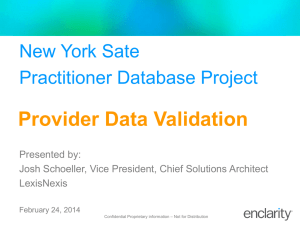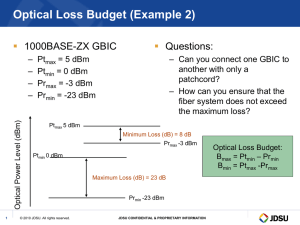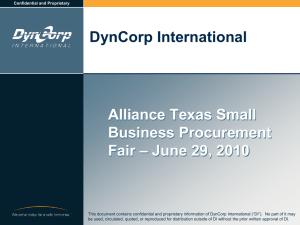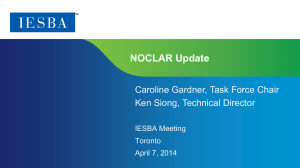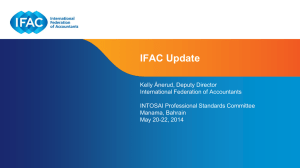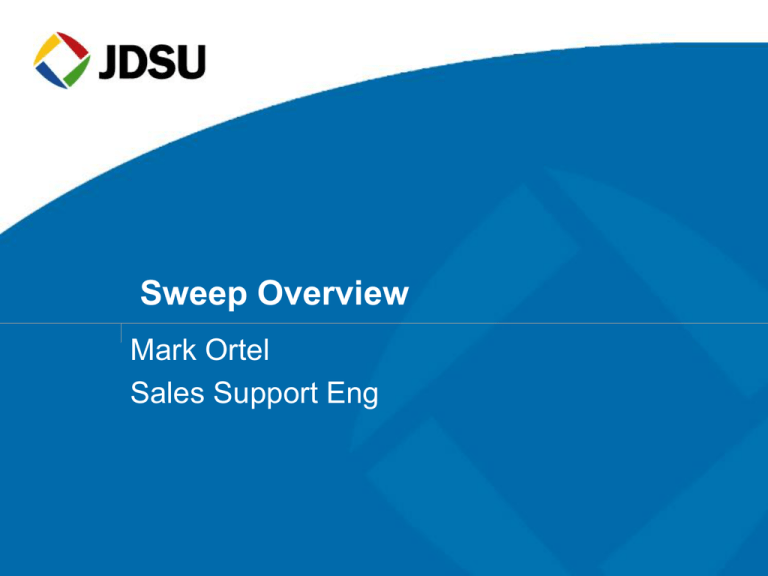
Sweep Overview
Mark Ortel
Sales Support Eng
Conditioning the Network for Triple Play Services
Know Your HFC Network
System Sweep and Ingress Suppression
Testing and Hardening the Drop (Home Wiring)
Line Conditioning to Optimize Two-way Plant Performance
Fiber Optic Testing Maintenance
2
© 2005 JDSU. All rights reserved.
JDSU CONFIDENTIAL & PROPRIETARY INFORMATION
Bandwidth Demand is Growing Exponentially
All Video on
Demand Unicast
per Subscriber
Megabits per Second
100
90
High Definition
Video on Demand
80
Video Blogs
70
Podcasting
60
Video on Demand
50
Video Mail
40
Online Gaming
30
Digital Photos
20
VoIP
10
E-mail
Digital Music
Web Browsing
Time
3
© 2005 JDSU. All rights reserved.
JDSU CONFIDENTIAL & PROPRIETARY INFORMATION
5
© 2005 JDSU. All rights reserved.
JDSU CONFIDENTIAL & PROPRIETARY INFORMATION
Voice Quality Impairments – it’s not always the plant!
Telco
Problem?
Cable Provider
Problem?
Customer
Problem?
Cable Provider
Problem?
Where is the Problem?
What is the Problem?
HUB SITE
MEDIA POP
PSTN
MediaGWTrunk Media
Slot-Port?
Gateway
DSP CardPort-CPU?
Router-SlotPort?
LSP/VLAN,
Route?
What’s
Core IPthe
Network
problem?
Trunk Media
Gateway
CORE IP NTWK
6
High utilization lead to
congestion causing jitter,
MEDIA GW POP dropped packets and
DSP codec
increased transit delay,
performance, echo
mis-configured routing
canceller config., jitter can cause inappropriate
buffer config. / packet hops leading to increased
drops
latency
© 2005 JDSU. All rights reserved.
Cable
CMTS
CMTS-BladePort or
Switch-SlotPort?
What’s the
problem?
PSTN
CMTS
CMTS
MEDIA POP
analog problems on PSTN
path passed through to IP
network
Aggregation
switch
What’s the
problem?
UPSTREAM or
DOWNSTREAM?
What’s the
problem?
Cable
Modem
MTA
POTS
Phone
HOME
CABLE PLANT
Background noise, handset
RF downstream and/or
speaker/mic interference,
HUB SITE
upstream errors leading to
inadequate volume, inside
Excessive NE polling IP packet loss, bandwidth
wiring, mis-configured MTA
and/or high utilization
capacity limitations (esp.
(CoS-Diffserv / firewall
lead to congestion
upstream) may lead to
settings), wireless phone
causing jitter, dropped CMTS congestion (dropped
delay exacerbates echo
packets and increased IP packets) and excessive
problems, MTA DSP/echo
transit delay
jitter (packet drops by codec)
canceller performance
JDSU CONFIDENTIAL & PROPRIETARY INFORMATION
‘Pre-HFC’ Networks
No Optics
Standardized ‘Tree & Branch’ Architecture
Few Amplifier Types
Limited Operating Levels
Networks were optimized for forward plant performance
with minimal reverse plant engineering.
7
© 2005 JDSU. All rights reserved.
JDSU CONFIDENTIAL & PROPRIETARY INFORMATION
‘Pre-HFC’ Networks
No Optics
Standardized ‘Tree & Branch’ Architecture
Few Amplifier Types
Limited Operating Levels
Headend
Networks were optimized for forward plant performance
with minimal reverse plant engineering.
8
© 2005 JDSU. All rights reserved.
JDSU CONFIDENTIAL & PROPRIETARY INFORMATION
HFC Networks
Combines fiber optics with coaxial distribution network
Return path is more sensitive than the forward path
Most of the ingress comes from home wiring on low value
taps
Wide variety of hardware with many connectors
Today’s ‘HFC” networks must be optimized for both
forward and reverse performance
9
© 2005 JDSU. All rights reserved.
JDSU CONFIDENTIAL & PROPRIETARY INFORMATION
HFC Network Architecture
NODE
10
© 2005 JDSU. All rights reserved.
JDSU CONFIDENTIAL & PROPRIETARY INFORMATION
HFC Network Architecture
NODE
11
© 2005 JDSU. All rights reserved.
JDSU CONFIDENTIAL & PROPRIETARY INFORMATION
Basic DOCSIS® Network
CMTS
Downstream Laser and
Upstream Optical Receivers
Fiber Nodes
Cable Modems
Downstream 0
Upstream 0
Cable Modems
Upstream 1
Cable Modems
Upstream 2
Cable Modems
Upstream 3
Coax
12
© 2005 JDSU. All rights reserved.
Fiber
JDSU CONFIDENTIAL & PROPRIETARY INFORMATION
Coax
Types of Lasers used in HFC Networks
Fabry-Pérot (FP)
– Less Expensive
– Mediocre Performance
– No Isolation or Cooling Required
Distributed Feedback (DFB)
– Expensive
– High Performance
– Isolation and Cooling Required
13
© 2005 JDSU. All rights reserved.
JDSU CONFIDENTIAL & PROPRIETARY INFORMATION
Forward System
Diverging System
Constant Outputs with Variable Inputs
Fixed Signals
– video / audio / digital carriers
System Noise
– is the sum of cascaded amplifiers
Balance or Align (Sweep)
– compensate for losses before the amp
14
© 2005 JDSU. All rights reserved.
JDSU CONFIDENTIAL & PROPRIETARY INFORMATION
Forward Path Unity Gain
OUT
+36 dBmV
IN
+12 dBmV
IN
+11 dBmV
OUT
+36 dBmV
OUT
+36 dBmV
2 dB
24 dB @ 750 MHz
AMP # 2
18 dB @ 750 MHz
AMP # 1
8 dB
23 dB @ 750 MHz
AMP # 3
IN
+10 dBmV
AMP # 4
OUT
+36 dBmV
15
© 2005 JDSU. All rights reserved.
JDSU CONFIDENTIAL & PROPRIETARY INFORMATION
Reverse System
Converging System
Constant Inputs with Variable Outputs
No Fixed Signals
– impulse digital carriers
System Noise
– is the sum of all active components
Balance or Align (Sweep)
– compensate for losses after the amp
16
© 2005 JDSU. All rights reserved.
JDSU CONFIDENTIAL & PROPRIETARY INFORMATION
Return Path Unity Gain
IN
+20 dBmV
OUT
+24 dBmV
OUT
+26 dBmV
IN
+20 dBmV
IN
+20 dBmV
2 dB
4 dB @ 40 MHz
AMP # 2
2 dB @ 40 MHz
AMP # 1
8 dB
4 dB @ 40 MHz
AMP # 3
OUT
+30 dBmV
AMP # 4
IN
+20 dBmV
17
© 2005 JDSU. All rights reserved.
JDSU CONFIDENTIAL & PROPRIETARY INFORMATION
Reverse Path Impairments
Ingress and electrical noise
Common Path Distortion (CPD)
Thermal (intrinsic) noise
Laser clipping noise
Micro-Reflections
18
© 2005 JDSU. All rights reserved.
JDSU CONFIDENTIAL & PROPRIETARY INFORMATION
Reverse Path Impairments
There are a variety of impairments that can affect
two-way operation.
They are classified in three main categories: stationary
impairments, which include thermal noise,
intermodulation distortion,and frequency response
problems; transient impairments, which include RF
ingress, impulse noise, and signal clipping; and
multiplicative impairments, which include transient
hum modulation and intermittent connections.
19
© 2005 JDSU. All rights reserved.
JDSU CONFIDENTIAL & PROPRIETARY INFORMATION
Reverse Path Impairments
Thermal noise —The majority of thermal noise is
generated in active components. Besides
choosing active equipment with a relatively low
noise figure, there is little else that you can do
about the thermal noise in active devices, other
than ensure proper network alignment.
20
© 2005 JDSU. All rights reserved.
JDSU CONFIDENTIAL & PROPRIETARY INFORMATION
Reverse Path Impairments
Intermodulation distortion—The most common
types of intermodulation distortion affecting the
reverse path are second and third order
distortions. These can be generated in
amplifiers and reverse lasers. A more troubling
type of intermodulation can occur in some
passive components. It is known as common
path distortion (CPD), and usually occurs at a
dissimilar metals interface where a thin oxide
layer has formed.
21
© 2005 JDSU. All rights reserved.
JDSU CONFIDENTIAL & PROPRIETARY INFORMATION
Reverse Path Impairments
Frequency response— Frequency response
problems are due to improper network
alignment, unterminated lines, or damaged
components. When reverse frequency
response and equipment alignment have
been done incorrectly or not at all, the result
can be excessive thermal noise, distortions,
and group delay errors.
22
© 2005 JDSU. All rights reserved.
JDSU CONFIDENTIAL & PROPRIETARY INFORMATION
Reverse Path Impairments
RF ingress — The 5-40 MHz reverse spectrum is shared
with numerous over-the-air users.
Signals in the over-the-air environment include high
power shortwave broadcasts, amateur radio, citizens
band, government, and other two-way radio
communications.
23
© 2005 JDSU. All rights reserved.
JDSU CONFIDENTIAL & PROPRIETARY INFORMATION
Downstream and Upstream
Noise Additions
Headend
Reverse System
“Noise Funneling”
Headend
Ingress from seven
amplifiers ends up
at the headend.
Forward Signals
Noise
Noise
24
© 2005 JDSU. All rights reserved.
JDSU CONFIDENTIAL & PROPRIETARY INFORMATION
Reverse Path Impairments
Impulse noise —Most reverse data
transmission errors have been found to be
caused by bursts of impulse noise. Impulse
noise is characterized by its fast risetime and
short duration.
Common sources include vehicle ignitions,
neon signs, static from lightning, power line
switching transients, electric motors,
electronic switches, and household
appliances.
25
© 2005 JDSU. All rights reserved.
JDSU CONFIDENTIAL & PROPRIETARY INFORMATION
Impulse Noise in the Upstream
26
© 2005 JDSU. All rights reserved.
JDSU CONFIDENTIAL & PROPRIETARY INFORMATION
Sample: “Loose Plant” Performance History
• Average noise floor
at 17 MHz varies
consistently by time
of day
• Indication of return
path with an ingress
problem.
•Maintenance now
will prevent future
problems
11:00PM
7:00AM
11:00PM
7:00AM
Single Frequency Time Window for 72 Hours from one return path
27
© 2005 JDSU. All rights reserved.
JDSU CONFIDENTIAL & PROPRIETARY INFORMATION
Sample: ‘Tight’ Performance History
• 17 MHz noise
floor tracked over
time
• Average noise
floor stays fairly
flat and consistent
over the 3 day
period
Inconsistent
Problem
(high peak,
low average)
Peak
Average
Minimum
Single Frequency Time Window for 72 Hours from one return path
28
© 2005 JDSU. All rights reserved.
JDSU CONFIDENTIAL & PROPRIETARY INFORMATION
Sample: “Telephony” Performance History
• Average
telephony signal at
36 MHz varies
consistently by
time of day
• Indication of
higher telephony
usage times
11:00PM
7:00AM
11:00PM
7:00AM
Single Frequency Time Window for 3 days from one return path
29
© 2005 JDSU. All rights reserved.
JDSU CONFIDENTIAL & PROPRIETARY INFORMATION
6MHz CPD
30
© 2005 JDSU. All rights reserved.
JDSU CONFIDENTIAL & PROPRIETARY INFORMATION
Reverse Path Impairments
Signal clipping —RF ingress and impulse
noise can cause signal clipping, or
compression, in reverse plant active
components. Excessive levels from in-home
devices such as pay-per-view converters also
can cause clipping. Clipping occurs in
reverse amplifiers and optical equipment.
31
© 2005 JDSU. All rights reserved.
JDSU CONFIDENTIAL & PROPRIETARY INFORMATION
Ingress
75 – 90% of ingress originates in the subscriber’s
home
To minimize the effects of ingress, operate the
subscriber terminals (modems & set-tops) near
maximum transmit level
32
© 2005 JDSU. All rights reserved.
JDSU CONFIDENTIAL & PROPRIETARY INFORMATION
Common Path Distortion (A.K.A. CPD)
Non-linear mixing from a diode junction
– Corrosion (metal oxide build-up) in the coaxial portion of the
HFC network
– Dissimilar metal contacts
– 4 main groups of metals
•
•
•
•
Magnesium and its alloys
Cadmium, Zinc, Aluminum and its alloys
Iron, Lead, Tin, & alloys (except stainless steel)
Copper, Chromium, Nickel, Silver, Gold, Platinum, Titanium,
Cobalt, Stainless Steel, and Graphite
Second and third order distortions
33
© 2005 JDSU. All rights reserved.
JDSU CONFIDENTIAL & PROPRIETARY INFORMATION
Common Path Distortion (A.K.A. CPD)
CPD distortions are
spaced at 6 MHz apart
from each other starting
at 6 MHz
24 MHz
34
© 2005 JDSU. All rights reserved.
JDSU CONFIDENTIAL & PROPRIETARY INFORMATION
24 Hour Performance History Max Hold Detail Graph
DOCSIS®
Modem
Carrier
Wide band
noise
beyond
42 MHz
diplex
roll-off
Diplex rolloff above
42 MHz
35
© 2005 JDSU. All rights reserved.
JDSU CONFIDENTIAL & PROPRIETARY INFORMATION
Thermal Noise and Laser Noise
Maintain a tight control of reverse RF signal levels
– Laser drive level too high
• causes excessive laser clipping
– Laser drive level too low
• reduces C/N and C/I ratios
Reverse levels must be held to a relatively narrow
‘window’ in order to guarantee that they fall
comfortably between a lower limit (imposed by the
noise floor) and a higher limit (set by laser clipping
noise)
36
© 2005 JDSU. All rights reserved.
JDSU CONFIDENTIAL & PROPRIETARY INFORMATION
Micro-reflections
Causes:
Damaged or missing end-of-line terminators
Damaged or missing chassis terminators on directional coupler, splitter, or
multiple-output amplifier unused ports
Loose center conductor seizure screws
Unused tap ports not terminated; this is especially critical on low value taps, but all
unused tap ports should be terminated with 75-ohm terminations (locking
terminators without resistors or stingers do not terminate the tap port)
Poor isolation in splitters, taps and directional couplers
Unused customer premises splitter and directional coupler ports not terminated
Use of so-called self-terminating taps at feeder ends-of-line; these are the
equivalent of splitters, and do not terminate the feeder cable unless all tap ports
are terminated
Kinked or damaged cable (includes cracked cable, which causes a reflection and
ingress)
Defective or damaged actives or passives (water-damaged, water-filled, cold
solder joint, corrosion, loose circuit board screws, etc.)
Cable-ready TVs and VCRs connected directly to the drop (return loss on most
cable-ready devices is poor)
Some traps and filters have been found to have poor return loss in the upstream,
especially those used for data-only service
RON HRANAC
rhranacj@cisco.com
37
© 2005 JDSU. All rights reserved.
JDSU CONFIDENTIAL & PROPRIETARY INFORMATION
Why Go Digital?
Efficiency
– Source signals are digital
• Standard and High Definition TV (SDTV, HDTV)
– High Speed Data and Digital Video is more efficient than analog
• Transmit equivalent of 6 to 10 analog channels (VCR quality) or 2 HDTV
programs over one 6 MHz bandwidth
Quality
– Better Picture and Sound Quality
– Less Susceptible to noise
• Error detection and correction is possible
Flexibility
– Data-casting easily multiplexed into digital signal
– Higher Data Security
38
© 2005 JDSU. All rights reserved.
JDSU CONFIDENTIAL & PROPRIETARY INFORMATION
What is Digital?
Source and Destination is digital data
– Assign unique patterns of 1’s and 0’s
Transmission path is via an analog QAM carrier
– Choice of modulation is the one that optimizes bandwidth
(data versus frequency ‘space’) and resiliency to noise
00
01
10
11
00
Generate Digital
© 2005 JDSU. All rights reserved.
10
Receive Digital
QAM Analog Carrier
39
01
JDSU CONFIDENTIAL & PROPRIETARY INFORMATION
11
Quadrature Amplitude Modulation (QAM)
QAM combines QPSK and AM modulation.
QAM uses 2 channels of information each carrying half
the data.
AM
Modulator
Bit Stream
10 11
I Channel
Carrier
Combine
r
Carrier
+ 90°
AM
Modulator
Q Channel
40
© 2005 JDSU. All rights reserved.
JDSU CONFIDENTIAL & PROPRIETARY INFORMATION
Vector Sum of I and Q Channels
Combining 2 carriers 90° of out of phase results in a carrier
with amplitude and phase modulation
4 Levels of Q
00
4 Levels
of I
Channel
11..
10
+
11
4 Levels of I
Data Stream ..10
01
=
00
01
4 Levels
of Q
Channel
11
41
© 2005 JDSU. All rights reserved.
..10 11..
10
16 QAM
JDSU CONFIDENTIAL & PROPRIETARY INFORMATION
Constellations, Symbols and Digital Bits
Each “dot” on constellation represents a unique symbol
Each unique symbol represents unique digital bits
Digital data is parsed into data lengths that encode the symbol
waveform
4 Levels of I
Channel
4 Levels of Q
Channel
16 QAM
42
© 2005 JDSU. All rights reserved.
JDSU CONFIDENTIAL & PROPRIETARY INFORMATION
64 QAM and 256 QAM
64 QAM has 8 levels of I and 8 levels of Q making
64 possible locations for the carrier
256 QAM has 16 levels of I and 16 levels of Q
making 256 possible locations for the carrier
8 Levels of I
Channel
16 Levels of I
Channel
16 Levels of Q
Channel
8 Levels of Q
Channel
64 QAM
43
© 2005 JDSU. All rights reserved.
256 QAM
JDSU CONFIDENTIAL & PROPRIETARY INFORMATION
QAM and CATV
16 QAM is part of the DOCSIS® 1.0/1.1 upstream
specifications
64 QAM and 256 QAM is used for both digital
video and DOCSIS downstream, allowing more
digital data transmission using the same 6 MHz
bandwidth
– Transmit equivalent of 10 to 12 analog channels (standard
definition) or 2 HDTV programs over one 6 MHz bandwidth
Standard for data over Cable
– Cable systems provide higher signal to noise ratios than
over-the-air transmission. A well designed and maintained
cable plant meets these QAM signal to noise requirements
44
© 2005 JDSU. All rights reserved.
JDSU CONFIDENTIAL & PROPRIETARY INFORMATION
QAM Data Capacity (Annex B)
45
16 QAM
64 QAM
256 QAM
(Upstream)
(Downstream)
(Downstream)
Symbol
Rate (Msps)
2.560
5.0569
5.3605
(@ 6 MHz)
(@ 6 MHz)
Bits per
symbol
4
6
8
Channel
Data Rate
(Mbps)
10.24
30.3417
42.8843
Information
bit
rate(Mbps)
9.0
26.9704
38.8107
Overhead
12.11%
11.11%
9.5%
© 2005 JDSU. All rights reserved.
(@ 3.20 MHz)
JDSU CONFIDENTIAL & PROPRIETARY INFORMATION
Constellation Display
The constellation is a visual representation of the I and Q plots
46
© 2005 JDSU. All rights reserved.
JDSU CONFIDENTIAL & PROPRIETARY INFORMATION
Effects of Noise and Interference
Noise and Interference moves the carrier away from its
ideal location causing a spreading of the cluster of dots.
Ideal
Locations
47
© 2005 JDSU. All rights reserved.
JDSU CONFIDENTIAL & PROPRIETARY INFORMATION
Modulation Error Ratio (MER)
Analogous to S/N or C/N
A measure of how tightly symbols are recorded
with respect to desired symbol location
MER(dB) = 20 x log RMS error magnitude
average symbol magnitude
Good MER
– 64 QAM: 28 dB MER
Average
symbol
– 256 QAM: 32 dB MER
magnitude
RMS
error
magnitude
48
© 2005 JDSU. All rights reserved.
JDSU CONFIDENTIAL & PROPRIETARY INFORMATION
Constellation Zoom
Zooming in on the constellation you can see how the
carrier spread and how close it came to the decision
boundaries.
Decision Boundaries
50
© 2005 JDSU. All rights reserved.
JDSU CONFIDENTIAL & PROPRIETARY INFORMATION
The Carrier, by the way, is ANALOG Modulation
Analog Content –
Analog Carrier
Digital Content
– Analog Carrier
51
© 2005 JDSU. All rights reserved.
JDSU CONFIDENTIAL & PROPRIETARY INFORMATION
PathTrak QAM Analyzer View – Good Node
MER & Level
Avg/Max/Min
QPSK & 16QAM
Constellation
Live MER, Level &
Symbol Count
MER & Level
Graphed over Time
52
© 2005 JDSU. All rights reserved.
JDSU CONFIDENTIAL & PROPRIETARY INFORMATION
PathTrak QAM Analyzer View – Bad Node
Interference easily
visible in 16 QAM
constellation
Interference causing
intermittent low MER
53
© 2005 JDSU. All rights reserved.
JDSU CONFIDENTIAL & PROPRIETARY INFORMATION
“Back to the Basics” Troubleshooting
Majority of problems are basic physical layer issues
Check AC power
Most of the test strategy remains the same – divide
and conquer technique
Check forward and return RF levels, analog and digital
Check forward / reverse ingress
Do a visual inspection of connectors / passives
Replace questionable connectors / passives
Tighten F-connectors per your company’s installation
policy
– Be very careful not to over tighten connectors on CPE (TVs,
VCRs, converters etc.) and crack or damage input RFI
integrity
54
© 2005 JDSU. All rights reserved.
JDSU CONFIDENTIAL & PROPRIETARY INFORMATION
System Sweep and Ingress
Suppression
Why sweep?
Why suppress Ingress?
WHY SWEEP?
• Less manpower needed
• Sweeping can reduce the number of service calls
Cracked hardline
found with SWEEP
Channel 12 video
problems
Internet not
working
VOD not
working
56
© 2005 JDSU. All rights reserved.
JDSU CONFIDENTIAL & PROPRIETARY INFORMATION
What faults cause CATV signals to fail ?
(80-90% of the time, the same faults…)
Success rate of finding and fixing the following
problems using:
–
–
–
–
–
–
–
–
–
–
–
57
5% Spectrum Analyzers
Signal Levels
7% Visual TV-picture inspection
TILT
11% BER Digital Analyzers
Gain / Loss
1
23% Signal Level Meters
21% Reverse Ingress
Suck-outs (notches)
C/N
72% Forward & Reverse Sweep
HUM
0
50
100
CTB/CSO Intermodulation
CPD - Forward and Reverse
Source: Research 11/97-2/98 Market survey with 200 US and European CATV operators
Reverse Ingress
BER / MER
Reflections / Standing waves
© 2005 JDSU. All rights reserved.
JDSU CONFIDENTIAL & PROPRIETARY INFORMATION
WHY SWEEP?
CATV amplifiers have a trade-off between noise and
distortion performance
Tightly controlling frequency response provides the
best compromise between noise and distortion.
58
© 2005 JDSU. All rights reserved.
JDSU CONFIDENTIAL & PROPRIETARY INFORMATION
Segmented Error Budgets
Test Critaria
Measurement
Goal
Start Seeing
Degradation on Call
Quality
Delay (1-way)
< 100 ms
> 150 ms
Jitter
Packet Loss
R-Value
< 5 ms
< 0.5%
> 80
> 15 ms
> 2%
< 70
MOS
>4
<3
MER
30dB(64), 33dB (256)
25dB(64), 28dB(256)
RF
At Home
PRE-FEC BER
Rx - Level
Tx - Level
MER
1.00E-09
-5~+5 dBmV
35 ~45 dBmV
32dB(64), 35dB (256)
1.00E-07
<-10dBmV or >+10dBmV
< 30dBmV or >50dBmV
28 dB(64), 31dB(256)
RF
At Node
PRE-FEC BER
Freq Response
Upstream SNR
1.00E-09
< 4dB
>35dB
1.00E-07
> 5dB
<25dB
CMTS
CMTS Loading
<50%
>80%
Service Level Test
59
© 2005 JDSU. All rights reserved.
JDSU CONFIDENTIAL & PROPRIETARY INFORMATION
Sweep Verifies Construction Quality
• Sweep can find craftsmanship or component
problems that aren’t revealed with other tests
• Damaged cable
• Poor connectorization
• Amplifier RF response throughout its frequency range
• Gain
• Slope
• Loose seizure screws, module hardware…….
60
© 2005 JDSU. All rights reserved.
JDSU CONFIDENTIAL & PROPRIETARY INFORMATION
Frequency Response Definition
System’s ability properly to transmit signals from
headend to subscriber throughout the designed
frequency range
“Sweep” tests verify performance to design
specifications
Expected Results: N/2 + X = max flatness variation
• where n = number of amplifiers in cascade
• where x = best case flatness figure
Typical Flattness formulas are:
n/10+1 old systems with 30 amp cascade 400 MHz
Bandwidth
N/2+2 new systems with and 5 to 7 amp cascade 750 MHz
Bandwidth
61
© 2005 JDSU. All rights reserved.
JDSU CONFIDENTIAL & PROPRIETARY INFORMATION
Test Probes
Will always be bi-directional unless they are in series
with the circuit
Higher loss probes provide less of an impedance
mismatch, but lower levels
F-to-Housing adapters cause severe standing waves
because of;
– Bad grounding
– RF power splitting
– Impedance mismatch
Be careful with in-line pads while probing seizure
screws
– Not usually dc blocked
62
© 2005 JDSU. All rights reserved.
JDSU CONFIDENTIAL & PROPRIETARY INFORMATION
Sweep Response of a Splitter
INPUT
RF
OUT
OUTPUT
63
© 2005 JDSU. All rights reserved.
JDSU CONFIDENTIAL & PROPRIETARY INFORMATION
RF
IN
100 ft of RG-59 cable
INPUT
RF
OUT
RF
IN
OUTPUT
64
© 2005 JDSU. All rights reserved.
JDSU CONFIDENTIAL & PROPRIETARY INFORMATION
Sweep Response of 17dB Tap
Tap
Port
Tap RF
Out
65
© 2005 JDSU. All rights reserved.
JDSU CONFIDENTIAL & PROPRIETARY INFORMATION
Sweep Response of a Amplifier
Amplifier
Forward
RF out
RF in
20dB
Amplifier
Return
12dB
RF out
66
© 2005 JDSU. All rights reserved.
JDSU CONFIDENTIAL & PROPRIETARY INFORMATION
RF in
A Sweep Finds Problems That Signal Level Measurements Miss
Misalignment
Standing Waves
Roll off at band edges
67
© 2005 JDSU. All rights reserved.
JDSU CONFIDENTIAL & PROPRIETARY INFORMATION
Balancing Amplifiers
Balancing amplifiers using tilt
Headend
Node Reference Signal
Lose Face Plate, or crack cable
shield
Sweep response
with a Resonant Frequency
Absorption
68
© 2005 JDSU. All rights reserved.
JDSU CONFIDENTIAL & PROPRIETARY INFORMATION
No Termination
Sweep response
with standing waves
Step 1) Forward & Reverse Sweep
WHY SWEEP?
Headend
Lose Face Plate, or crack cable
shield
No Termination
D = 492*Vp/F
F
Node Reference Signal
Sweep response
with a Resonant Frequency
Absorption
69
© 2005 JDSU. All rights reserved.
JDSU CONFIDENTIAL & PROPRIETARY INFORMATION
Sweep response
with standing waves
Types of Sweep
Sweepless Sweep
Forward Sweep
Return Sweep
70
© 2005 JDSU. All rights reserved.
JDSU CONFIDENTIAL & PROPRIETARY INFORMATION
“Sweepless” Sweep Method
Developed by Wavetek in the late 1980s
Compares headend levels to system test point
levels
Totally non-interfering (no sweep injection signal)
Relatively inexpensive (no headend unit)
Normal level variations in headed signals cause
loss of valid reference information
Blank spectrum not tested
71
© 2005 JDSU. All rights reserved.
JDSU CONFIDENTIAL & PROPRIETARY INFORMATION
‘Sweepless’ Sweep
72
© 2005 JDSU. All rights reserved.
JDSU CONFIDENTIAL & PROPRIETARY INFORMATION
Sweepless Sweep with Channel drop out
73
© 2005 JDSU. All rights reserved.
JDSU CONFIDENTIAL & PROPRIETARY INFORMATION
Sweep with Transmitter
Sweep transmitter and headend monitor
Constantly monitors video, audio, and digital carriers plus
sweep insertion points
Transmits any level variations to the SDA-5500 or DSAM
6000 on a telemetry carrier to update the reference
– Keeps receiver up to date on headend levels
74
© 2005 JDSU. All rights reserved.
JDSU CONFIDENTIAL & PROPRIETARY INFORMATION
Typical Forward Sweep Response
Fiber Node
75
© 2005 JDSU. All rights reserved.
Line Extender
JDSU CONFIDENTIAL & PROPRIETARY INFORMATION
End of Line Tap
Bench Sweep Amplifiers
Verify old modules
76
© 2005 JDSU. All rights reserved.
JDSU CONFIDENTIAL & PROPRIETARY INFORMATION
Beware of Taps
Port 1 thru 8 not terminated
77
© 2005 JDSU. All rights reserved.
Port 1 thru 8 terminated
JDSU CONFIDENTIAL & PROPRIETARY INFORMATION
System Problems
Resonant Frequency
absorption
Low end roll off
High end roll off
55.25 MHz
78
© 2005 JDSU. All rights reserved.
745.25 MHz
JDSU CONFIDENTIAL & PROPRIETARY INFORMATION
System Problem vs. Signature
100 MHz /
3 dB /
Signature
System Problem
79
© 2005 JDSU. All rights reserved.
JDSU CONFIDENTIAL & PROPRIETARY INFORMATION
Headend to Tap
Typical system not swept or balanced for 6 months
Ampifiers not
balanced
Cracked Hardline
System
System Sweep
Sweep Transmitter
Transmitter 3SR
3SR
Stealth Sweep
FILE
AUTO
1
abc
4
jkl
7
stu
2
5
def
3
mno
6
vwx
9
ghi
help
FREQ
pqr
status
CHAN
yz
ENTER
H
alpha
SETUP
8
x
. space
0
+/-
CLEAR
light
FCN
PRINT
LEVEL
TILT
SCAN
SW EEP
C/N
HUM
MOD
SPECT
L
SDA-5500 - Headend
unit
FCC Proof Failure
Customer Complaints
Noisy pictures!
HD Tiling
80
© 2005 JDSU. All rights reserved.
JDSU CONFIDENTIAL & PROPRIETARY INFORMATION
Headend to Tap
Typical system after Sweep and Balance
Ampifiers
balanced
Hardline good
Condition
System
System Sweep
Sweep Transmitter
Transmitter 3SR
3SR
Stealth Sweep
FILE
AUTO
1
abc
4
jkl
7
stu
2
5
def
3
mno
6
vwx
9
ghi
help
FREQ
pqr
status
CHAN
yz
ENTER
H
alpha
SETUP
8
x
. space
0
+/-
CLEAR
light
FCN
PRINT
LEVEL
TILT
SCAN
SW EEP
C/N
HUM
MOD
SPECT
L
SDA-5500 - Headend
unit
FCC Proof PASS!
Customers Satisfied!
81
© 2005 JDSU. All rights reserved.
JDSU CONFIDENTIAL & PROPRIETARY INFORMATION
Analog Integrity is Still Paramount, Supplemented by
Digital Measurements
Majority of “digital” issues involve basic analog
maintenance of the RF plant
–
–
–
–
–
–
83
Levels, including network tilt, must be optimized
RF distortions such as CSO and CTB can affect QAM carriers
Managing hum has been shown to improve QAM carrier quality
Carrier-to-noise and signal-to-noise (MER on QAM channels)
BER and DQI for intermittent impairments
Ingress management
© 2005 JDSU. All rights reserved.
JDSU CONFIDENTIAL & PROPRIETARY INFORMATION
Goal
The objective in reverse path alignment is to maintain unity
gain with constant inputs and minimize noise and ingress.
Set all optical receivers in the headend to same output level
and ideally the same noise floor to optimize C/N ratio.
– The reverse path noise is the summation of all noise from all the
amplifiers in the reverse path.
84
© 2005 JDSU. All rights reserved.
JDSU CONFIDENTIAL & PROPRIETARY INFORMATION
Sweep Reference Considerations
Typically the node is used for the reference
Use test probe designed for node/amp
It’s a good engineering practice to store a new reference
each day
Establish reference points to simplify ongoing maintenance
(sweep file overlay)
Need to know amps hidden losses in return path (Block
diagrams / Schematics)
Need to know where to inject sweep pulses and the
recommended injection levels
85
© 2005 JDSU. All rights reserved.
JDSU CONFIDENTIAL & PROPRIETARY INFORMATION
Optimizing the Node
Headend
System
System Sweep
Sweep Transmitter
Transmitter 3SR
3SR
Stealth Sweep
FILE
AUTO
1
abc
4
jkl
7
stu
2
5
def
3
mno
6
vwx
9
ghi
help
FREQ
pqr
status
CHAN
yz
ENTER
Forward
Laser
Activation and maintenance
of optical nodes by
DSAM 6000 with Reverse Sweep
alpha
SETUP
8
x
. space
0
+/-
CLEAR
H
light
FCN
PRINT
LEVEL
TILT
SCAN
SW EEP
C/N
HUM
MOD
SPECT
L
SDA-5500 - Headend
unit
Reverse-path
optical receivers
86
© 2005 JDSU. All rights reserved.
JDSU CONFIDENTIAL & PROPRIETARY INFORMATION
Activation and
maintenance
of the trunk network by
SDA-5000 + SDA-OPT1
or SDA-4040D
Return Path “X” LEVEL
X dBmV
NODE
Reverse
Combiner
Optical Receiver
Optical Receiver
Optical Receiver
Optical Receiver
X dBmV
NODE
NODE
NODE
Pad input of the SDA-5510
for 0 dBmV
System Sweep Transmitter 3SR
Stealth Sweep
FILE
1
abc 2
def 3
ghi
help
FREQ
AUTO
4
jkl
5
mno 6
pqr
status
CHAN
SETUP
7
stu 8
vwx 9
yz
x
CLEAR
.
space
0
+/-
PRINT
87
LEVEL
C/N
TILT
SCAN
SWEEP
HUM
MOD
SPECT
© 2005 JDSU. All rights reserved.
alpha
ENTER
light
FCN
All Return Path RF signal levels must be set
to same output “X” level at the optical
receiver in the headend or hubsite with the
same “X” level input at the node.
JDSU CONFIDENTIAL & PROPRIETARY INFORMATION
Return Path “X” LEVEL
X dBmV
NODE
Optical Receiver
Reverse
Combiner
X dBmV
Optical Receiver
Optical Receiver
Optical Receiver
NODE
X dBmV
X dBmV
NODE
NODE
Pad input of the SDA-5510
for 0 dBmV
System Sweep Transmitter 3SR
Stealth Sweep
FILE
1
abc 2
def 3
ghi
help
FREQ
AUTO
4
jkl
5
mno 6
pqr
status
CHAN
SETUP
7
stu 8
vwx 9
yz
x
CLEAR
.
space
0
+/-
PRINT
88
LEVEL
C/N
TILT
SCAN
SWEEP
HUM
MOD
SPECT
© 2005 JDSU. All rights reserved.
alpha
ENTER
light
FCN
All Return Path RF signal levels must be set
to same output “X” level at the optical
receiver in the headend or hubsite with the
same “X” level input at the node.
JDSU CONFIDENTIAL & PROPRIETARY INFORMATION
Return Path “X” LEVEL
X dBmV
NODE
Optical Receiver
Reverse
Combiner
X dBmV
Optical Receiver
X dBmV
Optical Receiver
Optical Receiver
NODE
NODE
X dBmV
X dBmV
X dBmV
NODE
Pad input of the SDA-5510
for 0 dBmV
System Sweep Transmitter 3SR
Stealth Sweep
FILE
1
abc 2
def 3
ghi
help
FREQ
AUTO
4
jkl
5
mno 6
pqr
status
CHAN
SETUP
7
stu 8
vwx 9
yz
x
CLEAR
.
space
0
+/-
PRINT
89
LEVEL
C/N
TILT
SCAN
SWEEP
HUM
MOD
SPECT
© 2005 JDSU. All rights reserved.
alpha
ENTER
light
FCN
All Return Path RF signal levels must be set
to same output “X” level at the optical
receiver in the headend or hubsite with the
same “X” level input at the node.
JDSU CONFIDENTIAL & PROPRIETARY INFORMATION
Return Path “X” LEVEL
X dBmV
NODE
Optical Receiver
Reverse
Combiner
X dBmV
Optical Receiver
X dBmV
X dBmV
Optical Receiver
Optical Receiver
NODE
NODE
NODE
X dBmV
X dBmV
X dBmV
X dBmV
Pad input of the SDA-5510
for 0 dBmV
System Sweep Transmitter 3SR
Stealth Sweep
FILE
1
abc 2
def 3
ghi
help
FREQ
AUTO
4
jkl
5
mno 6
pqr
status
CHAN
SETUP
7
stu 8
vwx 9
yz
x
CLEAR
.
space
0
+/-
PRINT
90
LEVEL
C/N
TILT
SCAN
SWEEP
HUM
MOD
SPECT
© 2005 JDSU. All rights reserved.
alpha
ENTER
light
FCN
All Return Path RF signal levels must be set
to same output “X” level at the optical
receiver in the headend or hubsite with the
same “X” level input at the node.
JDSU CONFIDENTIAL & PROPRIETARY INFORMATION
Reverse Noise Floor
X - 40 dB
NODE
Optical Receiver
Reverse
Combiner
X - 40 dB
Optical Receiver
X - 40 dB
X - 40 dB
Optical Receiver
Optical Receiver
NODE
1
abc 2
def 3
ghi
help
FREQ
AUTO
4
jkl
5
mno 6
pqr
status
CHAN
SETUP
7
stu 8
vwx 9
yz
x
CLEAR
.
91
C/N
TILT
SCAN
SWEEP
HUM
MOD
SPECT
Desired noise
floors into node
Stealth Sweep
FILE
space
0
+/-
PRINT
LEVEL
X - 40 dB
X - 40 dB
Return Telemetry must have
at least a 20 dB SNR
System Sweep Transmitter 3SR
X - 40 dB
NODE
NODE
X - 40 dB
© 2005 JDSU. All rights reserved.
alpha
ENTER
light
FCN
All Return noise floor levels should be
maintained to supply approximately “X level
minus 40 dB” going into the node.
JDSU CONFIDENTIAL & PROPRIETARY INFORMATION
ALIGNING THE RETURN PATH
Choose operating levels that maximize the
distortion performance of your return path
Get all the information that you can on your nodes
and amps from your manufacturer
Create a sweep procedure for your system
– make up a chart showing injection levels at each test
point
92
© 2005 JDSU. All rights reserved.
JDSU CONFIDENTIAL & PROPRIETARY INFORMATION
ALIGNING THE RETURN PATH
93
© 2005 JDSU. All rights reserved.
JDSU CONFIDENTIAL & PROPRIETARY INFORMATION
Test Point Compensation
Graphical user
interface
Store & recall of
test point setups
94
© 2005 JDSU. All rights reserved.
JDSU CONFIDENTIAL & PROPRIETARY INFORMATION
Test Point Compensation
Graphical user
interface
Store & recall of
test point setups
95
© 2005 JDSU. All rights reserved.
JDSU CONFIDENTIAL & PROPRIETARY INFORMATION
User Interface: Forward Sweep
Raw Forward Sweep
Reference the Sweep Trace
Save the Reference name
Referenced Sweep Trace
Save the File for Records
Choose & Save the File name
Troubleshoot or Move to
next device in the line
96
© 2005 JDSU. All rights reserved.
JDSU CONFIDENTIAL & PROPRIETARY INFORMATION
User Interface: Reverse Sweep
Raw Reverse Sweep
Reference the Sweep Trace
Save the Reference name
Referenced Reverse Sweep
Save the File for Records
Choose & Save the File name
Troubleshoot or Move to
next device in the line
97
© 2005 JDSU. All rights reserved.
JDSU CONFIDENTIAL & PROPRIETARY INFORMATION
User Interface: Test Point Compensation
Test Point Comp menu can be accessed two ways:
•Settings Hotkey in Sweep Measurement
•Shift+4 on the keypad at any time
List of current TPC Files
Create a new TPC file
Name and save the TP device
Edit new TPC file
Specify TP device loses
Pick Reverse Tel & Insertion levels
Forward summary specs
Reverse Summary Specs
TPC now active on all tests
98
© 2005 JDSU. All rights reserved.
JDSU CONFIDENTIAL & PROPRIETARY INFORMATION
User Interface: Markers and Zooming
Move Markers
to desired locations
Go to Zoom
Go to View Menu
New Frequency Range
99
© 2005 JDSU. All rights reserved.
JDSU CONFIDENTIAL & PROPRIETARY INFORMATION
User Interface: Sweep Settings
Turning on Tilt Compensation activates the Tilt settings
Select
Settings Tab
Sweep Settings
For bidirectional test points set the Reverse Sweep Port to Port 1
For directional test points set it to Port 2 and attach the reverse test point to port 2
and the forward test point to port 1
100
© 2005 JDSU. All rights reserved.
JDSU CONFIDENTIAL & PROPRIETARY INFORMATION
User Interface: Telemetry Settings
Set the telemetry of the SDA-5500 headend unit and SDA-5510 (if available)
Select
Settings Tab
PathTrak’s
Field View
Telemetry
Telemetry
Frequency
If using an SDA-5500 headend unit only set the reverse Sweep to Single User
If also using a SDA-5510 select Multi User for reverse Sweep
101
© 2005 JDSU. All rights reserved.
JDSU CONFIDENTIAL & PROPRIETARY INFORMATION
Sweeping Out
The sweep and alignment procedure for both the forward
and return path starts at the node and then moves toward
the end of line
NODE
X dBmV
Telemetry = X dBmV
Connect to Input Test Point on Node
102
© 2005 JDSU. All rights reserved.
JDSU CONFIDENTIAL & PROPRIETARY INFORMATION
Sweeping Out
Maintain unity gain with constant input
Set TP Loss as required
NODE
X dBmV
X dBmV
Telemetry = X dBmV
Connect to Input of First Reverse Amp
103
© 2005 JDSU. All rights reserved.
JDSU CONFIDENTIAL & PROPRIETARY INFORMATION
Sweeping Out
Maintain unity gain with constant input
Set TP Loss as required
NODE
X dBmV
X dBmV
X dBmV
Telemetry = X dBmV
Connect to Input of First Reverse Amp
104
© 2005 JDSU. All rights reserved.
JDSU CONFIDENTIAL & PROPRIETARY INFORMATION
Sweeping Out
Maintain unity gain with constant input
Set TP Loss as required
NODE
X dBmV
X dBmV
X dBmV
X dBmV
Telemetry = X dBmV
Connect to Input of First Reverse Amp
105
© 2005 JDSU. All rights reserved.
JDSU CONFIDENTIAL & PROPRIETARY INFORMATION
Sweeping Out
Maintain unity gain with constant input
Set TP Loss as required
NODE
X dBmV
X dBmV
X dBmV
X dBmV
X dBmV
Telemetry = X dBmV
Connect to Input of First Reverse Amp
106
© 2005 JDSU. All rights reserved.
JDSU CONFIDENTIAL & PROPRIETARY INFORMATION
Sweeping Out
Maintain unity gain with constant input
Set TP Loss as required
NODE
X dBmV
X dBmV
X dBmV
X dBmV
X dBmV
Telemetry = X dBmV
Connect to Input of First Reverse Amp
107
© 2005 JDSU. All rights reserved.
JDSU CONFIDENTIAL & PROPRIETARY INFORMATION
X dBmV
Common problems typically identified in
outside plant
Damaged or missing end-of-line terminators
Damaged or missing chassis terminators on directional coupler,
splitter or multiple-output amplifier unused ports
Loose center conductor seizure screws
Unused tap ports not terminated. This is especially critical on
lower value taps
Unused drop passive ports not terminated
Use of so-called self-terminating taps (4 dB two port; 8 dB four
port and 10/11 dB eight port) at feeder ends-of-line. Such taps
are splitters, and do not terminate the line unless all F ports are
properly terminated
108
© 2005 JDSU. All rights reserved.
JDSU CONFIDENTIAL & PROPRIETARY INFORMATION
Common problems typically identified in
outside plant
Kinked or damaged cable (including cracked cable, which causes a
reflection and ingress).
Defective or damaged actives or passives (water-damaged, waterfilled, cold solder joint, corrosion, loose circuit-board screws, etc.).
Cable-ready TVs and VCRs connected directly to the drop. (Return
loss on most cable-ready devices is poor.)
Some traps and filters have been found to have poor return loss in
the upstream, especially those used for data-only service.
109
© 2005 JDSU. All rights reserved.
JDSU CONFIDENTIAL & PROPRIETARY INFORMATION
Intermittent Connections
Poor craftsmanship on connectors
Loose center seizure screws & fiber connectors
Radial cracks in hard-line coaxial cable
Cold solder joints
Bad accessories
110
© 2005 JDSU. All rights reserved.
JDSU CONFIDENTIAL & PROPRIETARY INFORMATION
The Situation
Can’t justify taking the system down to troubleshoot
Unacceptable to the subscribers who will;
– Lose communication
– Get a slower throughput
– Have periodic “clicking” in their telephone calls
To be non-intrusive we must;
– Understand test points
– Apply new procedures and applications
– Learn new troubleshooting techniques
111
© 2005 JDSU. All rights reserved.
JDSU CONFIDENTIAL & PROPRIETARY INFORMATION
Typical Problem Areas
Taps
– Most ingress comes from houses with tap values of 17 dB or less
House Wiring
– Drop Cable & F Connectors are approximately ~95% of Problem
Amplifiers, hard line cable and the rest of the system are a
small percentage of the problem if a proper leakage
maintenance program is performed.
112
© 2005 JDSU. All rights reserved.
JDSU CONFIDENTIAL & PROPRIETARY INFORMATION
Taps
Taps are a combination of a DC
and a splitter network
Taps give an actual
representation of what the
subscriber is seeing and
transmitting in to
8 Port
23 dB
tap
Points to remember;
– Lower valued taps equal more
through loss
113
© 2005 JDSU. All rights reserved.
JDSU CONFIDENTIAL & PROPRIETARY INFORMATION
This would
be a DC-12
The splitter
network =
~11 dB of
loss
Testing at the Seizure Screws
If the problem is at the Forward Output, continue on
If the problem is at the Forward Input and not the Forward Output,
then the problem is from one of the drops
Spring loaded seizure screw probes create a good ground and quick
connect without causing outages
Input
Output
Forward Path
Return Path
114
© 2005 JDSU. All rights reserved.
JDSU CONFIDENTIAL & PROPRIETARY INFORMATION
Testing at the Seizure Screws
Use a 20 db pad with AC block when using spring
loaded seizure screw probes
Input
Output
Forward Path
Return Path
115
© 2005 JDSU. All rights reserved.
JDSU CONFIDENTIAL & PROPRIETARY INFORMATION
Taps are made up of a Directional Coupler and Splitters
In-Band Power
In-Band Power
10.393 dBmV
40
40
30
30
20
20
Probe the seizure
screw for ingress
10
0
-10
10
0
-10
-20
-20
-30
-30
-40
-40
-50
-50
-60
8.632 dBmV
-60
Span: 40.000 M Hz
RBW: 300 KHz
Center: 25.000 M Hz
VBW: 100 KHz
Dwell: 400 µS
Span: 40.000 M Hz
RBW: 300 KHz
Center: 25.000 M Hz
VBW: 100 KHz
Dwell: 400 µS
4 Port Tap
Disconnect one drop at a
time to determine the
point of entry
116
© 2005 JDSU. All rights reserved.
JDSU CONFIDENTIAL & PROPRIETARY INFORMATION
Taps - Probe the Seizure Screws for Ingress & CPD
If the problem is at
the FWD Output of
tap, continue on
towards end of line
If the problem is at the FWD Input and not the
FWD Output, then the problem is likely from one
of the drops
Forward Path
Return Path
Disconnect one drop at a
time to determine the
point of entry
117
© 2005 JDSU. All rights reserved.
JDSU CONFIDENTIAL & PROPRIETARY INFORMATION
Electrical Impulse Noise from One House
In-Band Power
10.393 dBmV
40
30
20
10
0
-10
-20
-30
-40
-50
-60
Span: 40.000 M Hz
RBW: 300 KHz
Center: 25.000 M Hz
VBW: 100 KHz
In-Band Power
Dwell: 400 µS
8.632 dBmV
40
30
20
10
0
-10
-20
-30
-40
•Reverse Spectrum shot at customer's drop
-50
-60
118
Span: 40.000 M Hz
RBW: 300 KHz
Center: 25.000 M Hz
VBW: 100 KHz
© 2005 JDSU. All rights reserved.
Dwell: 400 µS
JDSU CONFIDENTIAL & PROPRIETARY INFORMATION
PathTrak™ Field View Option
PathTrak Field View option combined
with JDSU meters provides a complete
“Find & Fix” field troubleshooting solution
•
•
•
119
PathTrak Field View option on SDA and
DSAM platform enables techs to greatly
reduce MTTR (Mean Time to Repair),
which increases customer satisfaction
and loyalty
PathTrak Field View option for DSAM
provides a programmable CW carrier to
aid in troubleshooting return problems
Both SDA and DSAM have low pass filter
for troubleshooting bi-directional test
points
© 2005 JDSU. All rights reserved.
JDSU CONFIDENTIAL & PROPRIETARY INFORMATION
Tracking Down Ingress and CPD
NODE
120
© 2005 JDSU. All rights reserved.
JDSU CONFIDENTIAL & PROPRIETARY INFORMATION
Live Spectrum Analysis – RBW Setting
RBW
Settings
121
© 2005 JDSU. All rights reserved.
JDSU CONFIDENTIAL & PROPRIETARY INFORMATION
Live Spectrum Analysis – RBW Setting
+19.61 dBmV
300kHz RBW
(Resolution Bandwidth setting)
122
© 2005 JDSU. All rights reserved.
JDSU CONFIDENTIAL & PROPRIETARY INFORMATION
Live Spectrum Analysis – RBW Setting
+25.95 dBmV
1,000kHz RBW
(Resolution Bandwidth setting)
123
© 2005 JDSU. All rights reserved.
JDSU CONFIDENTIAL & PROPRIETARY INFORMATION
Live Spectrum Analysis – RBW Setting
+11.31 dBmV
30kHz RBW
(Resolution Bandwidth setting)
124
© 2005 JDSU. All rights reserved.
JDSU CONFIDENTIAL & PROPRIETARY INFORMATION
Quick and Easy Spectrum Scan
View from 4 to 110 MHz
spectrum with programmable
pass/fail limits
Spectrum view with adjustable
marker and zoom function
Selectable peak hold
Store in work folder
Standard feature on DSAM
Platform
125
© 2005 JDSU. All rights reserved.
JDSU CONFIDENTIAL & PROPRIETARY INFORMATION
FM Band Ingress
126
© 2005 JDSU. All rights reserved.
JDSU CONFIDENTIAL & PROPRIETARY INFORMATION
Testing the RF Network
7 dB TAP
Return
Equalizer
Drop Cable
Disconnect drop from tap
and check for ingress
House
coming from customer’s
home wiring
OLDER TV SET
WIRELESS LAPTOP
DIGITAL SET-TOP
If ingress is detected,
terminate other end of
drop and scan spectrum
again for ingress
GROUND
BLOCK
COMPUTOR
2-Way
Amplifier
VoIP
High Pass
Filter
ETHERNET
3-Way
Splitter
eMTA-CABLE MODEM
INGRESS SPECTRUM MEASUREMENTS
127
© 2005 JDSU. All rights reserved.
JDSU CONFIDENTIAL & PROPRIETARY INFORMATION
ONLINE GAMING
Troubleshooting is “Back to the Basics”
Majority of problems are basic physical layer issues
Most of the tests remain the same
Check power
Check forward levels, analog and digital
Check forward / reverse ingress
Do a visual check of connectors / passives
Replace questionable connectors / passives
Tighten F-connectors per your company’s installation
policy
– Be very careful not to over tighten connectors on CPE (TVs,
VCRs, converters etc.) and crack or damage input RFI
integrity
128
© 2005 JDSU. All rights reserved.
JDSU CONFIDENTIAL & PROPRIETARY INFORMATION
Line Conditioning and Return Path
Equalization
Why should you worry about return
attenuation?
Level Control Scheme
Subscriber
terminal
level control
Node
combiner
Service
splitter
Reverse
receiver
Node
Optical link
RF distribution
Digital service
receiver &
demod.
Frequency
130
© 2005 JDSU. All rights reserved.
Target level
into laser
Level
Level
Target level
into receiver
Frequency
JDSU CONFIDENTIAL & PROPRIETARY INFORMATION
Optimizing (Conditioning) the Reverse Path
Adding reverse path attenuation –
–
–
–
–
131
enables flexible, more cost efficient design
increases C/N performance of communicating devices
reduces dynamic range of communication devices
reduces opportunities for reverse laser clipping
affords a ‘more forgiving’ network set-up during reverse
balance and alignment
© 2005 JDSU. All rights reserved.
JDSU CONFIDENTIAL & PROPRIETARY INFORMATION
Step Attenuators
Low value taps produce the majority of ingress and trouble calls within a typical HFC
network. This is due to the lack of sufficient reverse attenuation found in higher-value taps.
Applied directly to the tap port, Step Attenuators provide unity gain with all cable modems
and other critical reverse transmission products like digital voice and high-speed Internet.
-1.3 dB
5 MHz
54 MHz
-12 dB
40 MHz
132
© 2005 JDSU. All rights reserved.
JDSU CONFIDENTIAL & PROPRIETARY INFORMATION
Reverse ‘Window’
Problem: Reverse window can exceed dynamic
range of terminals
Required reverse input level:
22 dBmV
23
20
45.0
Forward levels:
45/35 dBmV
17
11
In red: required tap port reverse level
Terminal reverse 'window':
55 - 41 = 14 dB
NID
-10 dB
55 dBmV
-3 dB
© 2005 JDSU. All rights reserved.
NID
41 dBmV
Terminal
133
8
JDSU CONFIDENTIAL & PROPRIETARY INFORMATION
Terminal
38.0
Reduced Reverse ‘Window’
Same area, ‘NID’ design standardized
– reverse terminal ‘window’ improved by 7 dB
Required reverse input level:
22 dBmV
23
20
45.0
Forward levels:
45/35 dBmV
17
11
In red: required tap port reverse level
Terminal reverse 'window'
55 - 48 = 7 dB
NID
-10 dB
55 dBmV
-10 dB
© 2005 JDSU. All rights reserved.
NID
48 dBmV
Terminal
134
8
JDSU CONFIDENTIAL & PROPRIETARY INFORMATION
Terminal
38.0
Reverse Tap Port ‘Window’
- High Forward Levels, LEQ w/o RC Required Reverse Level @
Amplifier Input Port: 15 dBmV
DC-12
29
Forward levels:
51/41 dBmV
132'
110'
26
110'
23
120'
20
110'
11
110'
17
44.0
43.2
44.9
132'
In red: required tap port reverse level
41.0
14
43.3
120'
39.1
35.2
8
39.4
Reverse ‘Window’ of required tap port levels:
44.9 - 31.2 = 13.7 dB
135
8
© 2005 JDSU. All rights reserved.
JDSU CONFIDENTIAL & PROPRIETARY INFORMATION
31.2
Reverse Tap Port ‘Window’
- High Forward Levels, Using LEQ/RC Required Reverse Level @
Amplifier Input Port: 15 dBmV
DC-12
29
Forward levels:
51/41 dBmV
132'
110'
17
44.0
44.9
26
110'
43.2
132'
In blue: previous reverse level required
23
120'
41.0
14
43.3
120'
20
39.1
8
110'
11
44.2
35.2
110'
8
40.2
31.2
9 dB reverse
pad installed
39.4
Reverse ‘Window’ narrowed from 13.7 to: 44.9 39.1 = 5.8 dB
136
© 2005 JDSU. All rights reserved.
JDSU CONFIDENTIAL & PROPRIETARY INFORMATION
Reverse Tap Port ‘Window’
- Low Density, LEQ w/o RC Required reverse
level: 15 dBmV
29
1,560'
4
Forward levels:
51/41 dBmV
44.0
25.5
Reverse ‘Window”range of required tap port
levels: 44.0 - 25.5 = 18.5 dB
137
© 2005 JDSU. All rights reserved.
JDSU CONFIDENTIAL & PROPRIETARY INFORMATION
Reverse Tap Port ‘Window’
- Low Density, Using LEQ/RC -
Required reverse
level: 15 dBmV
29
1,560'
4
15 dB reverse
pad installed
Forward levels:
51/41 dBmV
44.0
In blue: previous reverse level required
40.5
25.5
Reverse ‘Window’ narrowed from 18.5 to: 44.0 40.5 = 4.5 dB
138
© 2005 JDSU. All rights reserved.
JDSU CONFIDENTIAL & PROPRIETARY INFORMATION
Noise Floor Levels
Be careful with spectrum analyzer level readings
The level is based off the RBW setting and will be very different from
one setting to another
A -20 dBmV noise floor with 30 kHz RBW is really 1.2 dBmV in a 4
MHz bandwidth
That’s why measurements with no point of reference are worthless
At least if there’s a reference carrier present, you can make a relative
measurement
139
© 2005 JDSU. All rights reserved.
JDSU CONFIDENTIAL & PROPRIETARY INFORMATION
Severe Transient Hum Modulation
The RF choke can saturate with too much current draw and
cause the ferrite material to break down
Same thing can happen in customer installed passives
Notice that this looks a lot like CPD
140
© 2005 JDSU. All rights reserved.
JDSU CONFIDENTIAL & PROPRIETARY INFORMATION
Center Pin/Seizure Screws
Typical connector problems
These may result in suckouts or roll off
Correct pin length,
Properly tightened
Pin length too short
141
© 2005 JDSU. All rights reserved.
JDSU CONFIDENTIAL & PROPRIETARY INFORMATION
Center Pin/Seizure Screws
Pin length too long
This may also hamper the “seating” of the RF
module
Overtightened seizure screw
Damaged pin
142
© 2005 JDSU. All rights reserved.
JDSU CONFIDENTIAL & PROPRIETARY INFORMATION
Center Pin/Seizure Screws
Pin tightened before turning
connector into housing
May result in a broken or
twisted pin inside the
connector
• A more typical result is the pin gets pushed back into
the connector instead of pushing past the seizure screw
• Happens a lot to housing terminators
143
© 2005 JDSU. All rights reserved.
JDSU CONFIDENTIAL & PROPRIETARY INFORMATION
Loose Fiber Connector
SC connector not pushed in all the way
Before
144
© 2005 JDSU. All rights reserved.
After
JDSU CONFIDENTIAL & PROPRIETARY INFORMATION
Fiber Connectors Are Everywhere
Fiber optic connectors are common throughout the network, and they
give you the power to add, drop, move and change the network.
Local Convergence
Point
Buildings
Network Access
Points
Head End
Feeder Cables
Distribution Cables
Coaxial Network
145
© 2005 JDSU. All rights reserved.
Residential
JDSU CONFIDENTIAL & PROPRIETARY INFORMATION
Multi-home
Units
Types of Contamination
A fiber end face should be free of any contamination or defects, as shown below:
SINGLEMODE
FIBER
Common types of contamination and defects include the following:
Dirt
146
© 2005 JDSU. All rights reserved.
Oil
Pits & Chips
JDSU CONFIDENTIAL & PROPRIETARY INFORMATION
Scratches
Where is it? – Everywhere
Your biggest problem is right in front of you… you just can’t see it!
DIRT IS EVERYWHERE!
147
Airborne, hands, clothing, bulkhead adapter,
dust caps, test equipment, etc.
The average dust particle is 2–5µ, which
is not visible to the human eye.
A single spec of dust can be a major
problem when embedded on or near the
fiber core.
Even a brand new connector can be dirty.
Dust caps protect the fiber end face, but can
also be a source of contamination.
Fiber inspection microscopes give you a
clear picture of the problems you are facing.
© 2005 JDSU. All rights reserved.
JDSU CONFIDENTIAL & PROPRIETARY INFORMATION
Where is it? – Proliferation of Dirt
There are a number of different sources where dirt and other particles
can contaminate the fiber.
Test Equipment
Dust Caps
Bulkheads
People
Environment
Connectors and ports on test equipment are mated frequently and are highly
likely to become contaminated. Once contaminated, this equipment will often
cross-contaminate the network connectors and ports being tested.
Inspecting and cleaning test ports and leads before testing
network connectors prevents cross-contamination.
148
© 2005 JDSU. All rights reserved.
JDSU CONFIDENTIAL & PROPRIETARY INFORMATION
Conclusion
If we want our telecommunications networks to be as
reliable/available as the telephony business at 99.98%, we
must;
–
–
–
–
Stay up with technology
Have contingency plans for everything
Train our employees
Utilize equipment that will quickly characterize and separate real
problems from insignificant events
– Be Proactive instead of Reactive!
149
© 2005 JDSU. All rights reserved.
JDSU CONFIDENTIAL & PROPRIETARY INFORMATION
Thank You !
Mark Ortel
Sales Support Engineer
Cable Networks Division
www.jdsu.com
SCTE Chapter
150
© 2005 JDSU. All rights reserved.
JDSU CONFIDENTIAL & PROPRIETARY INFORMATION

